
We drove to the Orange Empire Railway Museum and parked across the street at the Railway Elementary School then walked into the Museum bookstore and bought tickets for the 2:00 steam train ride before I went exploring. While I had been here many times in the past, I never had written a story about this great museum.
What was it that caused fourteen young members of the SC/ERA, the Southern California Division Of The Electric Railroaders' Association, to step forward in the early 1950s and focus on the preservation of electric rail interurbans and streetcars for the purpose of eventually creating an operating museum? In a sentence, "their world was slipping away". The SC/ERA was formed in 1950 to give organizational form to rail fans who were primarily interested in red cars and yellow cars of the local transit operations.
Buses were replacing Red Car and Yellow Car lines. Before long red cars were stacked four high at National Metal and Steel's scrap yard on Terminal Island along with rows of yellow cars. The last of the "Last Runs" were playing out. It was time for the equipment preservation conscious members of SC/ERA to form a separate organization with the purpose of establishing an operating trolley museum. Fourteen members of SC/ERA gathered in the home of Ronald Longworth on the evening of March 23rd, 1956 to discuss such an organization. At that meeting they chose the name Orange Empire Traction Company, adapting the name of an early Pacific Electric excursion through the inland empire of San Bernardino, Redlands and Riverside. At the first meeting, Pat Underwood was elected president, Jim Walker was selected as secretary and Dick Burns became treasurer.
On June 10th, 1956, at the home of Jim Walker in Lynwood, the group adopted articles of incorporation. Three members who were at least 21 years old and thereby eligible to sign a legal document signed the document. Those members were Richard H. Burns, Norman K. Johnson and Patrick L. Underwood. The signatures were notarized by Jim's father, Jim Walker, Sr.
TimelineA little over a month later, on July 20th, 1956, the State of California granted a charter of incorporation as a non-profit educational organization. The Orange Empire Traction Company's first home was at Travel Town, an already- established display of retired railway equipment in Los Angeles' Griffith Park. By 1958, the group had changed their name to the Orange Empire Trolley Museum and had brought 10 pieces of equipment to Travel Town. Then came the event that started the wheels in motion to form what would become today's Museum. Ironically, it was the same type of event that had hastened the demise of the equipment they were collecting: the construction of another of L.A.'s famous freeways. The group was informed that the new Ventura Freeway would cut directly through Griffith Park, isolating the site from access to major roadways.
The Orange Empire Trolley Museum found a new home on an abandoned railroad right-of-way just outside of rural Perris, California, some 70 miles southeast of Los Angeles. Except for a small two-room farmhouse and a rock dugout dating from the 1880s, the site was a lonely, semi-desert field. There was no running water, no indoor plumbing, not much of anything but trolley cars and youthful enthusiasm. The early years at Perris were a time of intense activity, though mostly on weekends, as almost all of the participants worked regular weekday jobs. Track was hurriedly extended as more and more trolleys arrived, eventually evolving into a yard arrangement. The few visitors that found the place thought of it as “the trolley farm” and this moniker would stay with the Museum for years to come. By late 1959 a used Cummins diesel generator power plant was acquired and set up to provide the 600 volt DC electricity for trolley car operation. Overhead wire followed and operations were soon possible on a short stretch of track.
As the 1960's began, tracks were extended further, and more trolleys and hardware acquired. With streetcar service ending in Los Angeles in 1963, the Orange Empire Trolley Museum began to gather momentum. Museum members travelled to sites throughout the region salvaging abandoned railway infrastructure that could be reused for the Museum. California Southern Railway Museum shared the site, and mainline railroad equipment continued to appear in large numbers.
By the mid-1960s, a core group of dedicated volunteers began to emerge. From among this core emerged leaders who began planning for the Museum's future. They identified more land, protective carhouses, a public restroom and a gift shop as priorities. By 1968, a trolley line had been constructed along the periphery of the original property, and the Pinacate Station gift shop and a public/member restroom building both opened. In 1969, construction started on the first carhouse, beginning the process of providing protective cover for the growing collection.
The Santa Fe Railway donated the historic 1892 Perris depot to the Museum. Although at the time the Museum could not yet operate its trains there, the building would later become a focal point in downtown Perris for both the Museum and the city's redevelopment efforts. Adjacent land was purchased, and the completion of a continuous trolley loop occurred. A major extension of the standard gauge mainline trackage in 1977 permitted a better demonstration of the growing collection of mainline railroad equipment.
In 1978, regular steam locomotive operations began, together with the concept of holding a large Rail Festival event in an effort to draw more visitors. A third carhouse opened in 1983, and construction of an ambitious shop facility progressed significantly.
In 1996, Carhouse 4 opened raising the number to fifty railcars in the collection with an indoor home (representing about one-third of the total collection at that time). This same year also saw electrification extended for several blocks over the trackage connecting the Museum's main line to the Santa Fe trackage in downtown Perris. In 1992, Ward and Betty Kimball donated their 3-foot gauge Grizzly Flats Railroad along with major funding to help assure its continued preservation. The four track Grizzly Flats Enginehouse opened.
In 1993, Landscaped park was added, connecting the center of the Museum with the new enginehouse. In 2003, Grizzly Flats was further expanded with the addition of a replica Southern Pacific gallows type turntable, built on site by Museum volunteers with financial support from the Kimballs. Acquired 19 additional acres of adjacent property, which gave it the ability to site a major new collections storage facility.
In 2006, OERM celebrated its 50th Anniversary then a year later, the 62,000 square foot Ron Ruffulo Carhouse was completed, which has six tracks inside, each 600 feet long. This facility doubled the amount of indoor storage space
for the Museum’s collections, permitting a major cleanup and reorganization of the entire site.
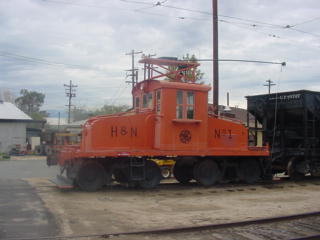
Hutchinson & Northern steeplecab 1 built by General Electric Company in 1921, which originally operated in Kansas.
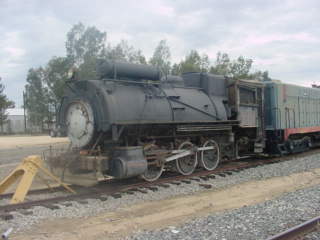
Mojave Northern 0-6-0T 2 built by Davenport in 1917. It later was transferred to Southwest Portland Cement 2 before being donated to the museum.
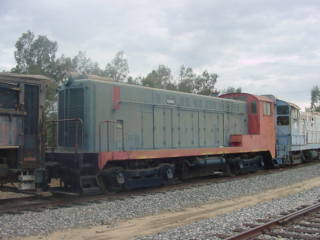
Port of Los Angeles VO-1000 8 built by Baldwin in 1945 as United States Navy 2.
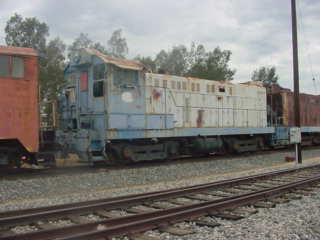
Kerr McGee S-12 845, formerly Southern Pacific 1550, built by Baldwin in 1953.
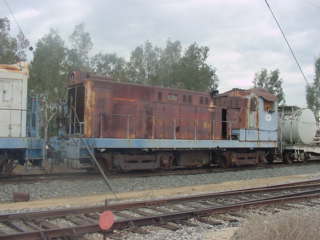
Kerr McGee S-12 844, formerly Southern Pacific 1543, built by Baldwin in 1953.
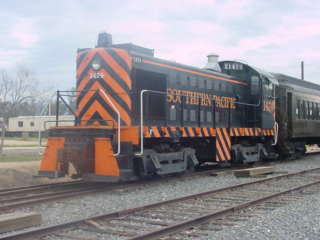
Southern Pacific S-4 1474 built by American Locomotive Company in 1952.
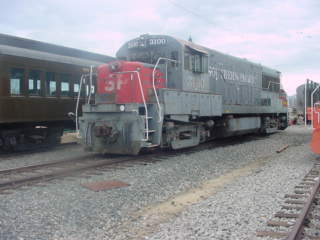
Southern Pacific U25-B 3100, built by General Electric in 1963, which was first numbered as Southern Pacific 7508, then became Southern Pacific 6708 during the railroad's 1965 general renumbering.
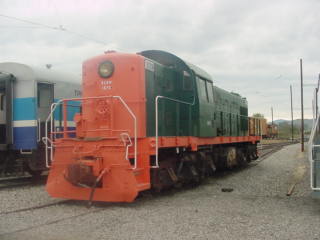
Orange Empire Railway Museum MRSD-1 1975, ex. Department of Transportation 015, nee United States Air Force 8018 built by American Locomotive Company in 1942.
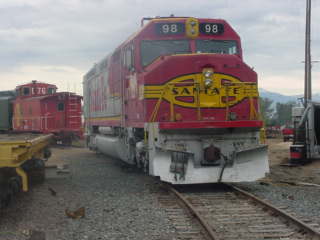
Santa Fe FP45 98, ex. BNSF 98, exx. ATSF 5998, exxx. ATSF 102, exxxx. ATSF 5998, exxxxx. ATSF 5948, nee ATSF 108 built by Electro-Motive Division in 1967. This was the last FP45 bought by the railway and was the first of two to be re-painted in Superfleet red and silver livery in 1989.
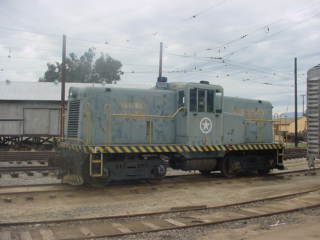
United States Air Force B-B-90/90 8580 built by General Electric in 1944.
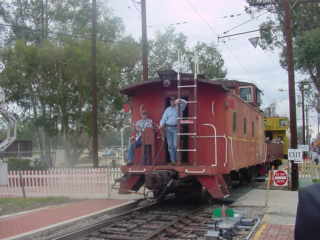
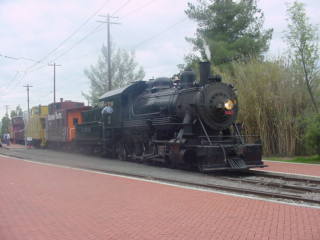
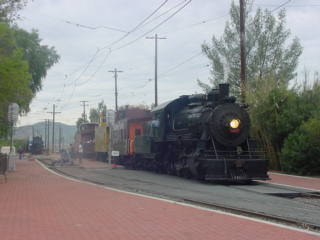
Ventura County 2-6-2 2 reversed train into the station after the 1:00 PM run.
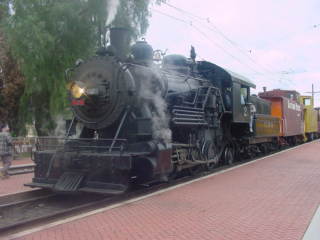
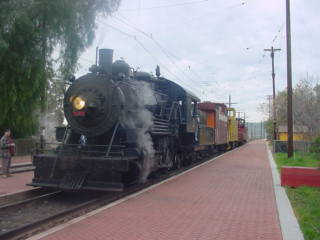
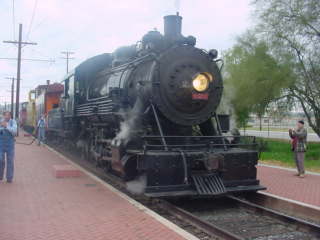
Ventura County Railway 2-6-2 built by Baldwin in 1922, sitting at the station. It was watered then Chris and I boarded the open car while Larry rode in the Southern Pacific caboose. At 2:00 PM, we departed for Milepost 18 north of Perris near Neuvo Road.
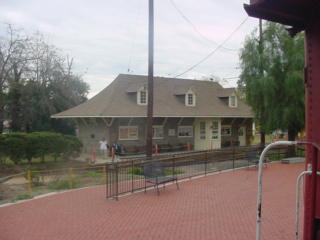
The Pinacate station museum and store.
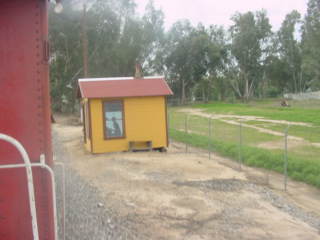
The Oil Junction station from outside Bakersfield.
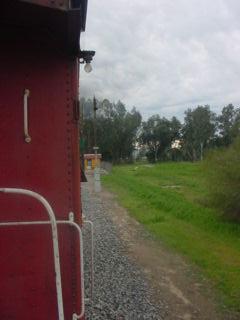
Passing a semaphore signal.
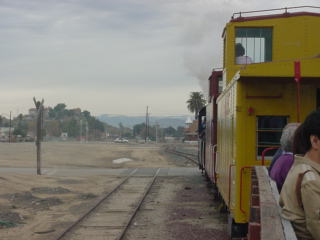
Near downtown Perris, we entered the BNSF line with the Perris station ahead.
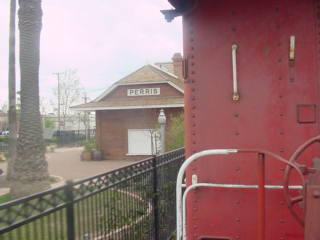
The former Santa Fe Perris station built in 1892.
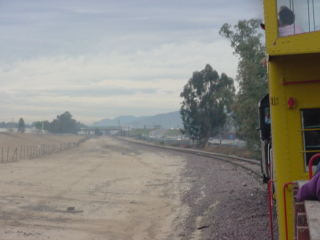
Approaching Neuvo Road, the bridge ahead of our train. Just short of that was our destination before we would return to the museum.
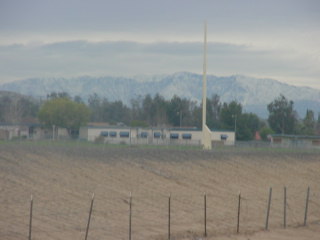
Mt. Baldy to the north.
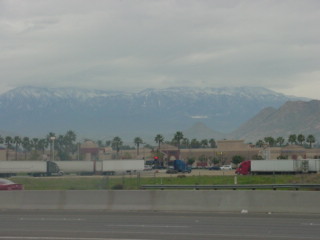
Mt. San Gorgonio was covered by clouds to the northeast.
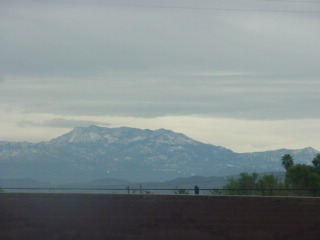
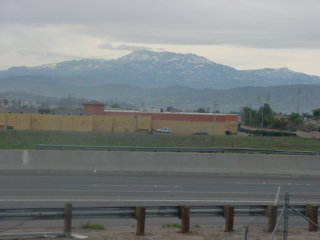
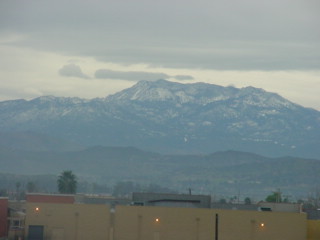
Mt. San Jacinto to the east.
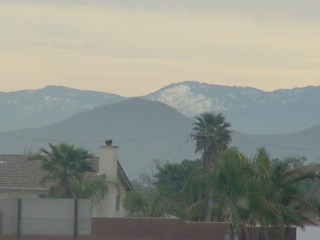
Mount Palomar to the south.
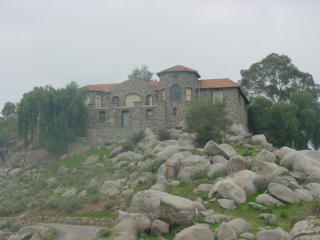
The famous Rock House on the hill is a Perris landmark.
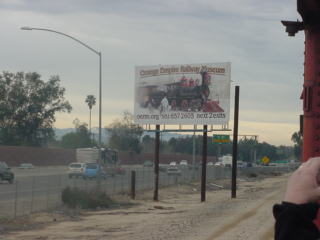
The sign for the museum along Interstate 215.
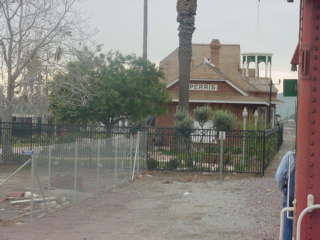
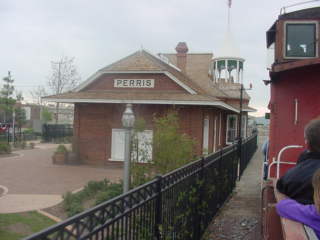

The former Santa Fe Perris station on the way back.
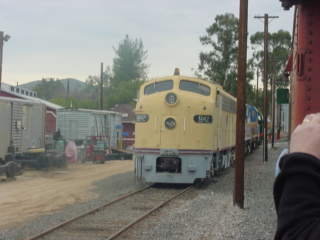
On the way back to the boarding area at the Museum, we passed Union Pacific E8 942 in Pie Yard. We detrained and walked over to the Grizzly Flats Railroad building, which began in Ward and Betty Kimball's San Gabriel, California back yard. Ward, who was then an animator for Walt Disney Studios and avid railroad enthusiast, decided to buy the last passenger coach from Southern Pacific's narrow gauge subsidiary, the Carson & Colorado Railroad. With a friend's prompting, he then bought 2-6-0 2, once named "Sidney Dillon", which had operated on the Nevada Central since 1881.
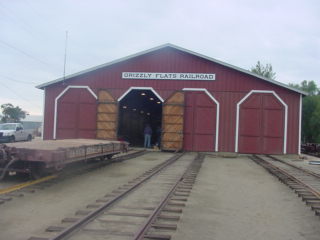
The Grizzly Flats building.
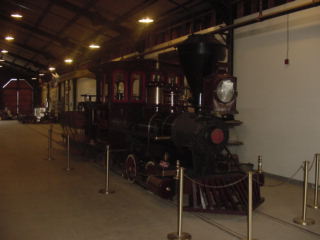
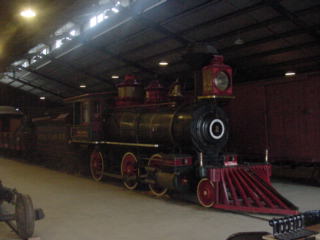
Grizzly Flats Railroad Nevada Central 2-6-0 2 "Emma Nevada" built by Baldwin in 1881.
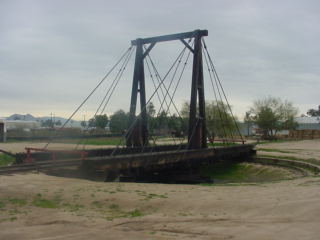
The gallows turntable from the Grizzly Flats Railroad.
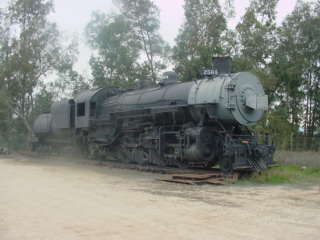
Union Pacific 2-8-2 2564 built by American Locomotive Company in 1922.
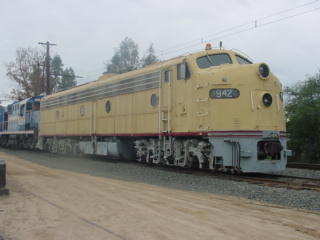
Union Pacific E8A 942 built by Electro-Motive Division in 1952 and later Chicago and North Western/Metra 510.
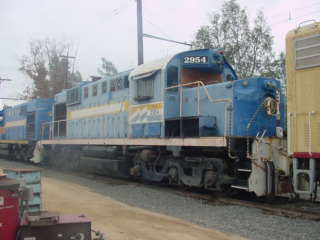
Southern Pacific RSD12 2954 built by American Locomotive Company in 1961.
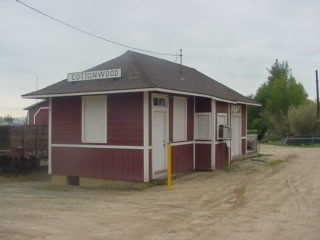
In Pie Yard is Cottonwood station which was originally a lumber yard office and retail store in Perris. Acquired by the museum in 1968 with the intent of being part of a proposed main entrance and moved to the present site by volunteers, it ended up as the branch line station that exists today. In 1995, various Hollywood studios performed some cosmetic repairs and painting and filmed some exterior scenes for several films. A full conversion into a branch line station commenced in February 2005.
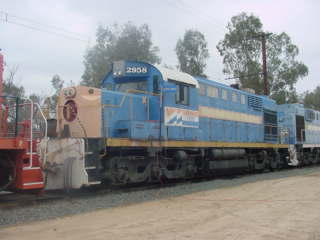
Southern Pacific RSD12 2958 built by American Locomotive Company in 1961 and United States Air Force 1601 built by General Electric in 1951.
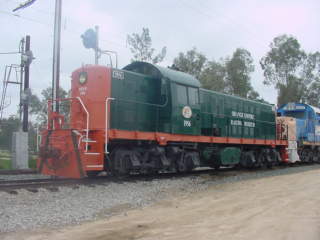
Orange Empire Railway Museum RSD-1 1956, ex. Department of Transportation 012, nee United States Army 8009 built by American Locomotive Company in 1941.
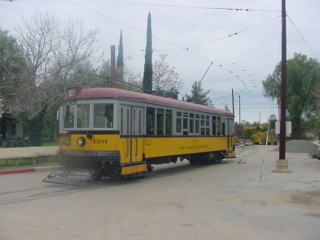
Los Angeles Railway Type H Streetcar 1201 built by St. Louis Car Company in 1921.
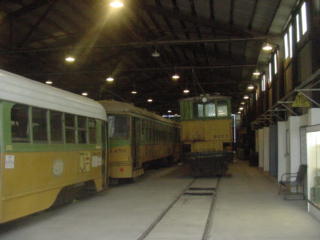
Inside the Narrow Gauge car barn.
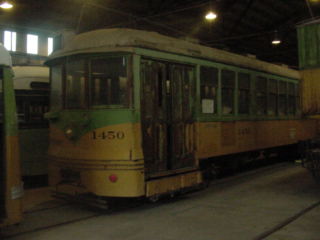
Los Angeles Railway 1450 built by the St Louis Car Company in 1924. During 1919-1920, the engineers of the Los Angeles Railway designed a new type of car for the Eagle Rock-Hawthorne "E Line". These cars, designated Type H, were to be the first LARy cars of all steel construction and the first to be equipped with control equipment and couplers for multiple-unit operation. The Type H cars were intended to supplement and eventually replace the wooden-bodied, single unit operation Type B "Huntington Standard" cars.
1450 was unique in being a "test car". While the Type H cars had Westinghouse mechanical components, 1450 had a mix of Westinghouse and General Electric components. In 1928, Los Angeles Railway raised the car fare from 5 cents to 7 cents. In response to negative feedback from riders, cars 1441-1450 were modernized in December of 1929 and re-designated as Type H-3. The controls of H-3 cars were mechanically redesigned to be capable of one man (operator only) or two man (operator and conductor) operation. Automatic double doors were installed on each end of the cars complete with folding steps. For the comfort of the passengers, the two open sections had windows installed with added ventilation ports between the sections. The car interior was upgraded, including the addition of leather upholstered seats. Most shocking to the public, the cars were painted a cream and green paint scheme with gold lettering. Type H-3 1441 debuted to the public on August 13, 1930 and proved extremely popular.
The Los Angeles Railway was sold in January 1945 to Los Angeles Transit Lines, a subsidiary of National City Lines. LATL began a modernization campaign of the Type H-4 cars in mid-1945. Eclipse fenders were removed in favor of lifeguard fenders. Skirting under the car body gave a semi streamlined appearance. Most noticeably, the cars were repainted into the yellow, green, and cream National City Lines "Fruit Salad" livery. The Type H-3 cars followed in 1947, with full modernization and conversion to one man operation.
1955 saw a major abandonment of rail service with the F, 5, 7, 8, and 9 Lines being replaced with bus service causing a mass retirement of 195 Type H-4 cars. Retired cars were sold to National Metals for scrap and disposition. 61 cars were sold and saw many more years of service in Seoul, South Korea. The Type H-3 and 19 remaining Type H-4 cars continued to serve the S and W Lines with supplemental night service on the R Line. With the abandonment of the W Line in 1956, the H-3 cars and eight H-4’s served the S Line.
Los Angeles Transit Lines was absorbed by the Los Angeles Metropolitan Transit Authority in March 1958. LAMTA installed turning loops at the end of the S Line to accommodate the streamlined Type P, single-ended PCC cars. The last of the Type H cars were retired in the summer of 1958 and placed into storage. 1450 had the distinction of being the last Type Car operated in Los Angeles in 1958 on and Excursion sponsored by SCERA. Cars 1423, 1444, and 1450 were sold to the Orange Empire Trolley Museum and moved to the museum in Perris.
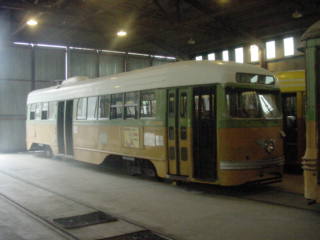
Los Angeles Transit Lines PCC car 3100 built by St. Louis Car Company in 1943.
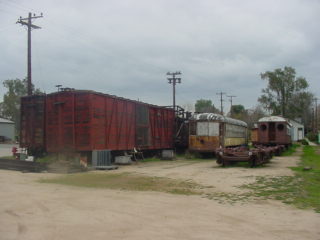
Outside view of unrestored cars and box cars.
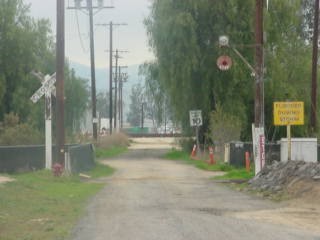
A scene that could have been eighty years ago.
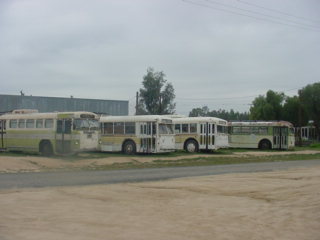
The buses of the museum.
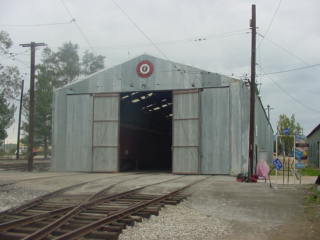
The Pacific Electric car barn.
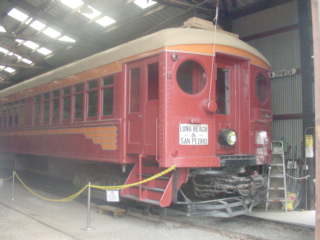
Pacific Electric Interurban MU Coach "Blimp" 418 built by Pullman in 1913 as Interurban Electric Railway 344. It was sold as United States Marine Corps 344 in 1942 and sold as Pacific Electric Railway 4614 in April 1944. It was rebuilt in 1947 as 418 and became Los Angeles Metropolitan Transit Authority 1528 in 1958. It was retired in 1961 and went to Orange Empire Railway Museum where it was restored as Pacific Electric 418.
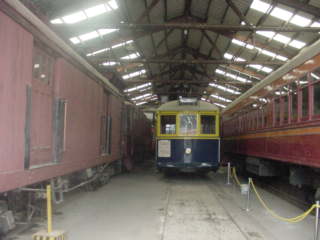
Inside the Standard car barn.
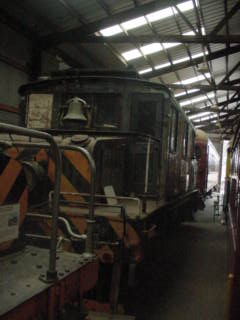
Pacific Electric steeplecab 1624 built by Baldwin-Westinghouse in 1912.
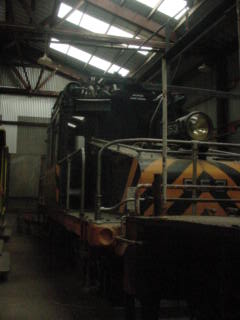
Sacramento Northern steeplecab 653 built by General Electric in 1928.
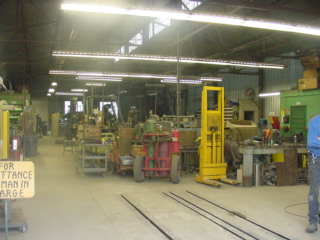
I walked next to the Machine Shop and talked with one of the volunteers for a few minutes.
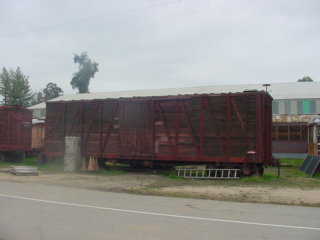
Southern Pacific outside braced box car 1354 built circa 1925.
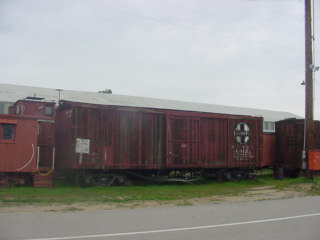
Santa Fe wooden box car 49131 built by Pullman in 1912.
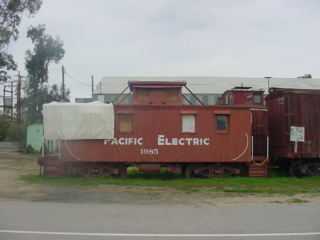
Pacific Electric wooden caboose 1985 built in 1905 by the Richmond, Fredericksburg and Potomac Railroad and acquired in 1950.
Chris and I then met and borrowed Larry's car to chase the 3:30 PM last run of the steam train. We drove out to our first runby location and waited then minutes later, heard a whistle off in the distance then after a few more minutes, the gates at the crossing to the south started to go down, more whistling and our train came into view.
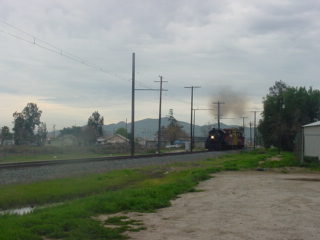
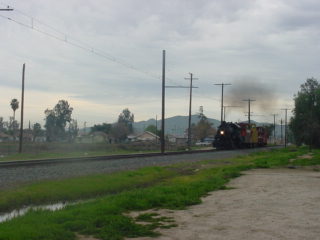

After these pictures, we hopped back in the car and drove three blocks.
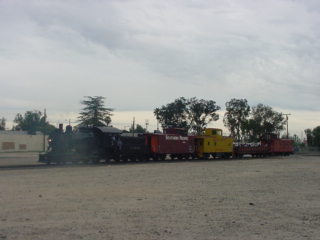
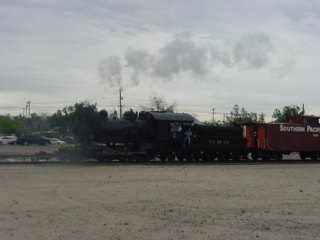
Our final runby was not what we thought. We took the pictures then drove out to Mertz Park, climbed up on the embankment and waited. However, the train did not run out this far for this particular run so we wasted our time as the train had turned and was on its way back to the museum.
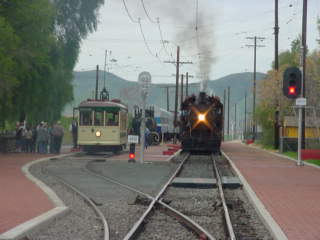
Back at the museum, this view before I went to the loading ramp and waited for the engine to pass on its way to the car barn in which it lives.
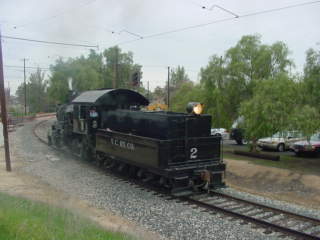
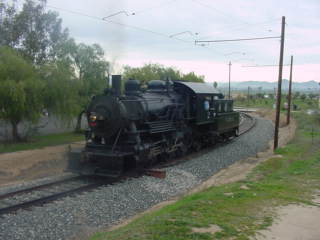
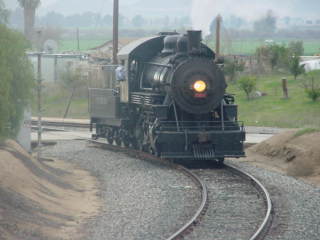
Ventura County 2, a most beautiful steam engine.
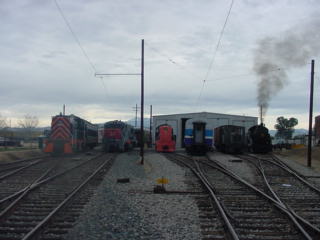
A line of engines.
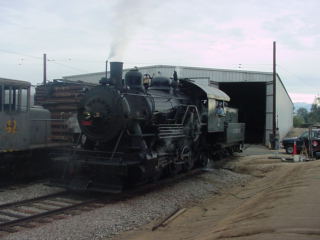
Ventura County 2 being turned off to be put away.
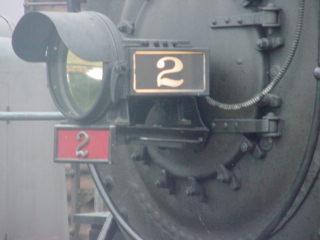
The headlight and number board.
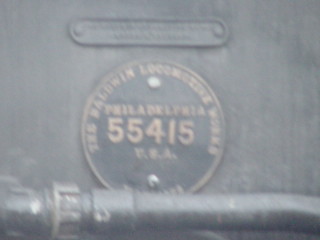
The builder's plate.
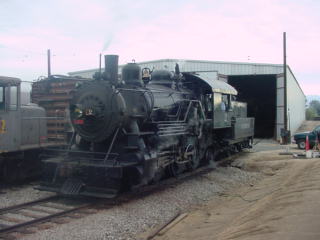
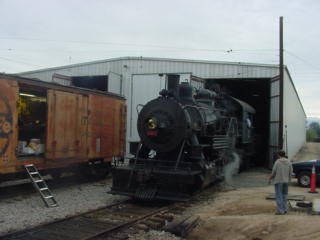

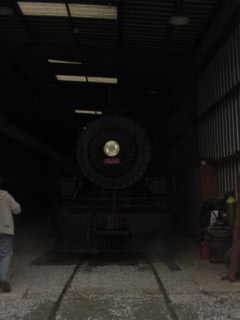
Ventura County 2 reversed into its car barn until the next time.
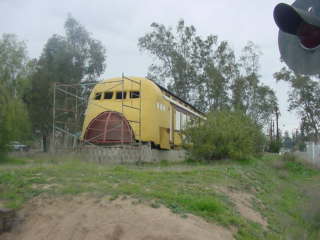
O'Neill's Streamlined Diner built in the 1930's fashioned from Santa Fe coach 721 built by Pullman in 1906. It became a roadside café near March Air Force Base, then at some point, the stucco end was added to make it look like a Union Pacific streamliner. As Highway 395 was improved over the years, the car was relocated twice. With the final upgrade of the Highway to freeway standards, the car was obtained by the State and they moved it to a storage location and after two offers from the State, it was acquired by the Museum.
We met Larry at the bookstore before driving home and it had been a fantastic steamy Sunday at both the Riverside Live Steamers and Orange Empire Railway Museum.
| RETURN TO THE MAIN PAGE |